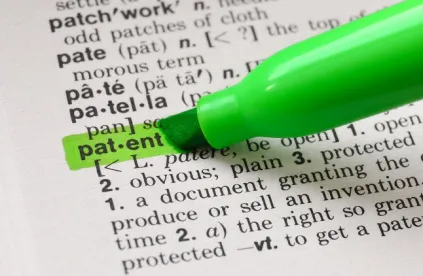Earlier this year, the United States Patent and Trademark Office (USPTO or “the Office”) published the 2019 Revised Subject Matter Eligibility Guidance1 (2019 PEG), which set forth newly revised procedures to be used by USPTO personnel in evaluating subject matter eligibility under 35 U.S.C. § 101. The 2019 PEG was developed in response to concerns that the Office was inconsistently applying the eligibility criteria set forth in Mayo2, Alice3, and other court decisions. While patent holders generally welcomed the 2019 PEG, the Office also received many comments that indicated the need for further clarification of the updated subject matter eligibility examination guidelines.
In response to these comments, the Office published the October 2019 Patent Eligibility Guidance Update4 (PEG Update), which provides clarification to the 2019 PEG in five areas: (1) evaluation of whether a claim recites a judicial exception; (2) the groupings of abstract ideas enumerated in the 2019 PEG; (3) evaluation of whether a judicial exception is integrated into a practical application; (4) the prima facie case and the role of evidence with respect to eligibility rejections; and (5) the application of the 2019 Patent Eligibility Guidance in the patent examining corps. This article summarizes the highlights for each of these clarifications.
Evaluation of Whether a Claim Recites a Judicial Exception
The 2019 PEG requires patent examiners to determine whether a claim “recites” a judicial exception (i.e., recites an abstract idea, law of nature, or a natural phenomenon). Many of the comments received by the Office expressed concern that the 2019 PEG was not sufficiently clear regarding what it means to “recite” a judicial exception. The PEG Update clarifies that a claim “recites” a judicial exception if the claim explicitly “sets forth” a judicial exception or if the claim “describes” the exception, consistent with how the term “recites” is used in Section 2106.04 (II) of the Manual of Patent Examining Procedure (“MPEP”). The PEG update then refers to the specific examples of abstract ideas, laws of nature, and products of nature in the 2019 PEG update to determine whether a claim “recites” an exception.
The Groupings of Abstract Ideas Enumerated in the 2019 PEG
One of the most significant changes to USPTO examination procedure set forth in the 2019 PEG relates to how patent examiners are supposed to determine whether a claim recites an “abstract idea.” Prior to the 2019 PEG, examiners had to rely primarily on a growing patchwork of (frequently inconsistent) published court cases to make this determination. The 2019 PEG simplified this process by grouping so-called “abstract ideas” into three enumerated groupings: mathematical concepts, certain methods of organizing human activity, and mental processes. In doing so, the PEG Update intentionally shifts “examiners’ focus from relying on individual cases to generally applying the wide body of case law spanning all technologies and claim types.” Moreover, examiners should identify all abstract groupings that may apply to a particular claim. Furthermore, the PEG Update provides a Tentative Abstract Idea Procedure for situations where the claim does not fall with an enumerated class of abstract ideas, but nonetheless, the Examiner determines that the claim should be treated as an abstract idea based on Supreme Court or Federal Circuit precedent. In such a situation, the Examiner will need the Technology Center (TC) Director’s approval for issuing a subject matter rejection under § 101 for such tentative abstract ideas. The PEG Update provides additional guidance for each of these enumerated groupings of abstract ideas.
Mathematical Concepts
The Office declined to adopt suggestions that different types of math recited in patent claims should receive different treatment with regard to subject matter eligibility. The Office also clarified that a claim does not “recite” a mathematical concept if it merely involves or is based on a mathematical concept, provided the mathematical concept is not recited in the claim. The PEG Update highlights three examples of a mathematical concept: (1) a mathematical relationship, which is a relationship between variables or numbers; (2) a mathematical formula or equation; and (3) a mathematical calculation, which is a mathematical operation (such as multiplication) or an act of calculating using mathematical methods to determine a variable or number.
Certain Methods of Organizing Human Activity
The 2019 PEG sets forth three sub-groupings of “certain methods of organizing human activity”: (1) fundamental economic practices or principles; (2) commercial or legal interactions; and (3) managing personal behavior or relationships or interactions between people. The PEG Update notes that the term “certain” is a qualifier and “not all methods of organizing human activity are abstract ideas.” The sub-groupings encompass both activity of either a single person or multiple persons, and can include activity between a person and a computer. The PEG Update noted that the number of persons involved in the activity is irrelevant and reiterates the Office’s position that the determination of whether a claim falls within the human activity grouping should not be expanded beyond the three sub-groupings, except in rare circumstances. Additionally, the PEG Update provides examples of each of these three subcategories based on applicable Federal Circuit and Supreme Court decisions.
Mental Processes
The PEG Update clarifies how examiners are supposed to evaluate whether a claim recites a mental process by noting that (1) a claim with limitations that cannot be practically performed in the human mind (such as detecting suspicious activity by using network monitors and analyzing network packets) does not recite a mental process, (2) a claim that requires a computer may still recite a mental process, such as when the steps could be performed without the aid of a computer, and (3) a claim that encompasses a human performing the step(s) mentally with the aid of a pen and paper recites a mental process. The Office rejected suggestions that this category should be limited to claims where the process is performed entirely in the human mind, as that interpretation is not consistent with current § 101 case law. Accordingly, product and computer-readable medium claims may recite mental processes, especially if the data analysis steps are recited at a high level of generality such that they could practically be performed in the human mind. However, for more specific processing, the guidelines seek to limit the examiner’s ability to characterize all computer processing as a “mental process,” such as concatenating a 64-bit string in an encryption application that could not be “practically” performed in the human mind.
Evaluation of Whether a Judicial Exception is Integrated into a Practical Application
In cases where the examiner rejects an assertion that the invention improves technology, the PEG Update indicates that the burden shifts to the applicant to prove patentability. The applicant may respond by submitting evidence under 37 C.F.R § 1.132, such as a declaration providing testimony on how one of ordinary skill in the art would interpret the disclosed invention as improving technology. Accordingly, because this a very fact-specific inquiry under 35 U.S.C § 101, applicants may need to be prepared to document the improvement explicitly in the specification or later submit objective evidence demonstrating that the invention is an actual improvement in technology.Under the 2019 PEG, even if a patent claim “recites” a judicial exception (Step 2A, Prong One), the claim may still be patentable subject matter if the claim as a whole “integrates the recited judicial exception into a practical application of that exception” (Step 2A, Prong Two). The PEG Update provides a further explanation of what it means to integrate the judicial exception into a practical application. Claims that reflect an improvement in the functioning of a computer or other technology, for example, qualify as “integrating the judicial exception into a practical application.” The PEG Update points out that the specification itself does not need to recite the improvement explicitly, nor does the claim itself need to recite an improvement described in the specification. However, the PEG Update points to MPEP 2106.04(a) and 2106.05(a), which indicate that the specification should “disclose sufficient details such that one of ordinary skill in the art would recognize the claimed invention as providing an improvement” and that “the claim itself must reflect the improvement in the technology.” The examiner must consider the claim as a whole (i.e., the limitations containing the judicial exception together with the additional elements) to determine whether the claim integrates the judicial exception into a practical application.
Requirements of a Prima Facie Case
In response to suggestions from patent stakeholders, the PEG Update reiterates that the burden is on patent examiners to establish a prima facie case of subject matter ineligibility when making a § 101 rejection, and that patent examiners should explain “clearly and specifically” why claims are ineligible. Furthermore, “[w]henever practicable, examiners should indicate how subject matter ineligibility rejections might be overcome.” Not only must examiners identify any judicial exceptions to patent eligibility, but examiners must also explain (1) why additional claim elements result in a practical application under Prong Two of Step 2A and (2) why the claim as a whole meets the “significantly more” standard of Step 2B. By requiring examiners to demonstrate why a claim is directed to unpatentable subject matter, applicants will now have sufficient notice so they may effectively respond to such rejections under § 101.
Application of the 2019 PEG in the Patent Examining Corps
The PEG Update addresses concerns about examiner training and the ability of applicants to obtain redress when examiners fail to follow the 2019 PEG. Notably, the PEG Update explains that applicants appealing to the Patent Trial and Appeal Board (PTAB) can rely on the 2019 PEG to support arguments that a § 101 rejection is in error, although it is the § 101 rejection itself that the PTAB will review, not any alleged failure to comply with the 2019 PEG. However, an examiner’s failure to comply with the 2019 PEG and the corresponding PEG Update may show that the particular § 101 rejection is not soundly based. By continually requiring examiners to provide the reasons for subject matter rejections under § 101, the Office is placing applicants in a better position to respond to such rejections and expedite prosecution.
1 84 Fed. Reg. 50 (Jan. 7, 2019).
2 Mayo Collaborative Services v. Prometheus Laboratories, 132 S. Ct. 1289 (2012).
3 Alice Corp. v. CLS Bank Int’l, 134 S. Ct. 2347 (2014).
4 Notice provided at 84 Fed. Reg. 55942 (Oct. 18, 2019); substance of the PEG Update.
5 84 Fed. Reg. at 53.
6 MPEP 2106.04(a).





 />i
/>i

